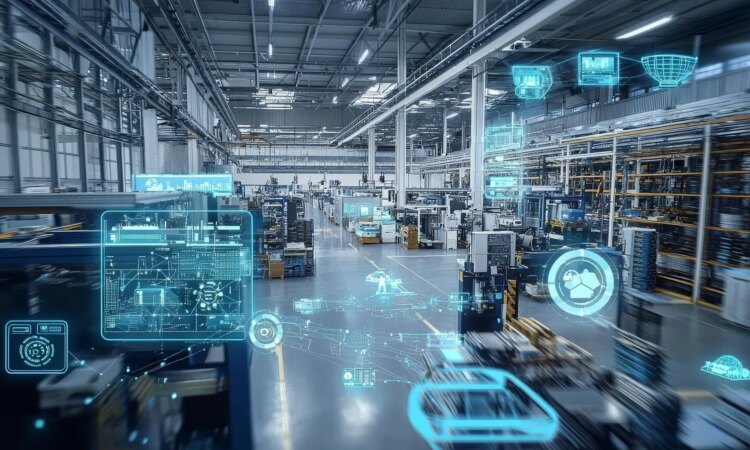
Manufacturing transforms from Industry 4.0 fascination to practical human-machine collaboration in 2026, with AI agents autonomously managing factory operations while generative design moves from prototype to production.
Adobe Stock
In 2026, focus is shifting from excitement over what AI can do in manufacturing to a more mature, considered understanding of what human-machine collaboration should look like in practice.
Industries that gained first-mover advantage by adopting cognitive, connected processes are developing a deeper awareness of the challenges, complexities and cultural changes created by Industry 4.0.
At the same time, breakthroughs in material science and immersive technology are redefining the way we design and build the products customers want. Manufacturing is becoming an intelligent ecosystem, with automation and connectivity built into tools and processes from the ground up.
So here are what I believe will be the key trends driving the next phase of the industrial revolution as we head into 2026.
1. Cognitive Industry: The Rise Of Industrial AI Agents In Manufacturing And Industry
Agents will be game-changers for manufacturers in 2026; rather than simply analyzing data and generating information, they will take action. This means planning, operating, managing and overseeing factory operations in real-time with minimal human interaction. Connecting sensors, industrial machinery and human resources, we will see them coordinating complex industrial workflows end-to-end, bringing the goal of truly autonomous “smart factories” closer to reality than ever. Imagine AI systems that manage inventory, adjust purchase orders and manage production processes to avoid bottlenecks and reduce downtime. Use of agentic systems in manufacturing is predicted to quadruple by 2027, making it a key trend driving growth over the coming 12 months.
2. Generative Design: From Pilot To Production
Imagine simply feeding a generative AI tool the specifications, performance targets, material requirements and price constraints for a new product and having it instantly output a design blueprint. That’s the vision for generative design in industry, and in 2026, we will see it move from prototyping and pilot stage to production use. No longer a pipe dream, it’s already in use by manufacturers, including Jabob Design, which used it to create an improved life support backpack system for NASA, reducing the mass of its device by 50 percent and shortening design time by 20 percent. In 2026, more manufacturers will follow this lead, integrating genAI design into CAD workflows in order to accelerate prototyping and optimize material use.
3. Industrial Extended Reality
Virtual and augmented reality (VR/AR) are merging with other technologies, including digital twins and AI agents, to create spatial interfaces in manufacturing. Augmented with conversational AI interfaces, engineers and technicians can get instant on-the-job information and guidance; equipping manufacturing workers with headsets has already enabled Airbus to cut assembly time by 15 percent and enabled Boeing to reduce errors made during visual inspections by 40 percent. In 2026, we will see further evolution of the industrial metaverse, as virtual spaces and augmented vision interfaces enable manufacturers to reimagine human-machine collaboration.
4. Intelligent Supply Chains
Thanks to AI, digital twins and edge computing, supply chains in 2026 are no longer passive processes; they are proactive, autonomous and adaptive. These intelligent supply chains dynamically change in real time, in response to sensor data, supplier availability or even global disruption. With unified industrial IoT systems orchestrating sourcing, inventory, production and delivery, organizations will automate resilience against costly supply chain disruptions that frequently drive up expense and resource waste. Over the next 12 months, intelligent supply chain automation will increasingly drive competitive advantage as manufacturers seek to build resilience amid turbulent economic and geopolitical times.
5. Smart Materials In Manufacturing
In 2026, it isn’t just industrial processes that are changing—the very materials that we use to manufacture the world around us are evolving, too. Additive manufacturing (for example, 3D printing), nanomanufacturing and breakthroughs in material science are leading to the development of new alloys with enhanced tensile strength and reduced weight, and “metamaterials” with qualities not found in nature. This is leading to the creation of construction materials that block sounds or improve earthquake resilience, and regulate heat more effectively in buildings. They are being used to create more effective antennas for sensing and communication devices and to improve the performance of lenses. With the market for smart materials predicted to grow annually by eight percent to reach $133.10 billion by 2030, this year, industry leaders will treat materials as systems in themselves, rather than simple static building blocks for their products.
6. Industry 5.0: Human-Centric, Sustainable Automation
Industry 5.0 refers to the fast-emerging concept of reframing innovation and automation around human work, following the focus on machine intelligence of recent years. It’s an umbrella term covering everything from ensuring human workforces are equipped with the skills to work alongside AI and robots on the shop floor, to developing human-centric interfaces like wearables to amplify, rather than replace, human capabilities, to using technology sustainably so as not to harm the environment that supports human society. Balancing automation with human safety and avoiding developing an over-reliance on AI systems all play a part in Industry 5.0 strategy, which will become integral to industrial progress and innovation in 2026.
The manufacturing revolution of 2026 marks a fundamental shift in how we balance human expertise with machine capability. As AI agents manage operations, generative design accelerates innovation, and smart materials redefine what’s possible, the most successful manufacturers will be those who use technology to amplify human potential while building resilience and sustainability into every layer of their operations.







